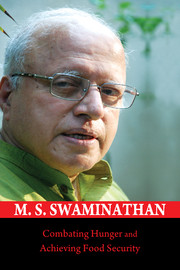Book contents
- Frontmatter
- Contents
- Foreword
- Preface
- Acknowledgements
- Abbreviations
- 1 Genesis and Growth of the Yield Revolution in Wheat
- 2 Our Agricultural Heritage
- 3 Shaping Our Agricultural Destiny
- 4 Thrust on Farm Revival
- 5 Nutri-farm Movement
- 6 Nutrition-sensitive Agriculture
- 7 Food Losses and Food Waste
- 8 Rice in Zero Hunger Challenge
- 9 Monsoon Management
- 10 Importance of Ecological Conservation
- 11 Caring for Ecology and Heritage
- 12 Conserving Biodiversity
- 13 Overcoming Hidden Hunger through Aquaculture
- 14 Biofuels – The Way to Go
- 15 Food Security
- 16 Vigilance for Sustainable Food Security
- 17 Food Security and Social Protection
- 18 Food Security and its Role
- 19 Sustaining the Livestock Revolution
- 20 Challenges in the Year of Science
- 21 Agriculture and Humanism
- 22 Fostering the Science of Science Communication
- 23 Olympic Move for Saving Children
- 24 Youth: The Agents of Change
- 25 Role of Women in Agricultural Production
- 26 Know-how to Do-how
- 27 From Bengal Famine to Right to Food
- 28 Financial Institutions and Fighting Food Inflation
- 29 Public Good Research in Agriculture
- 30 The Future of Indian Agriculture
- Bibliography
29 - Public Good Research in Agriculture
Published online by Cambridge University Press: 18 December 2015
- Frontmatter
- Contents
- Foreword
- Preface
- Acknowledgements
- Abbreviations
- 1 Genesis and Growth of the Yield Revolution in Wheat
- 2 Our Agricultural Heritage
- 3 Shaping Our Agricultural Destiny
- 4 Thrust on Farm Revival
- 5 Nutri-farm Movement
- 6 Nutrition-sensitive Agriculture
- 7 Food Losses and Food Waste
- 8 Rice in Zero Hunger Challenge
- 9 Monsoon Management
- 10 Importance of Ecological Conservation
- 11 Caring for Ecology and Heritage
- 12 Conserving Biodiversity
- 13 Overcoming Hidden Hunger through Aquaculture
- 14 Biofuels – The Way to Go
- 15 Food Security
- 16 Vigilance for Sustainable Food Security
- 17 Food Security and Social Protection
- 18 Food Security and its Role
- 19 Sustaining the Livestock Revolution
- 20 Challenges in the Year of Science
- 21 Agriculture and Humanism
- 22 Fostering the Science of Science Communication
- 23 Olympic Move for Saving Children
- 24 Youth: The Agents of Change
- 25 Role of Women in Agricultural Production
- 26 Know-how to Do-how
- 27 From Bengal Famine to Right to Food
- 28 Financial Institutions and Fighting Food Inflation
- 29 Public Good Research in Agriculture
- 30 The Future of Indian Agriculture
- Bibliography
Summary
Public good research in agriculture is designed to promote risk minimizing agronomy and also the ease of adoption by small and marginal farmers. For example, public good research institutions concentrate on the development of varieties rather than hybrids, since in the case of hybrids, the farmer has to buy the seed every year from the company. In contrast, farmers can keep their own seeds of good varieties of wheat, rice, maize and other crops. We should not underestimate the power of public good research in contrast to profit maximizing private sector research. I shall try to illustrate this from two recent examples, one dealing with basmati rice and another with semi-dwarf wheat varieties.
Basmati rice is appropriately referred to as the Queen of Rice and has been cultivated since centuries in the foothills of the Himalayas. Because of its cooking quality, it is valued highly in national and international markets. Pakistan also grows basmati rice. After the advent of the high-yielding varieties of rice possessing genes for semi-dwarf character, basmati rice was given less importance due to its tall stature and low-yield potential (about 1 tonne per hectare). It is to overcome this difficulty that the IARI started developing semi-dwarf basmati strains, which can respond well to fertilizer and irrigation water application. This work, which began nearly 40 years ago has now resulted in outstanding varieties like Pusa Basmati 1121, which has helped increase foreign exchange earnings by 33,000 crore during 2013–14. During this year IARI released another variety Pusa Basmati 1509, which matures in 120 days and has dwarf stature, sturdy stem, non-lodging and non-shattering habit. Also, Basmati 1509 yields about five tonnes per hectare. Because of its early maturity, Pusa Basmati 1509 has become very popular among farmers adopting a rice–wheat rotation. No wonder, there is enormous demand for the seeds of this variety, which is now occupying a major portion of the basmati area. This is a good example of the power of public good research, with a sharp focus on increasing the productivity and profitability of small holdings.
As in the case of Pusa Basmati rice, the IARI has also been developing and releasing wheat varieties, which help increase the production and productivity of this crop.
- Type
- Chapter
- Information
- Combating Hunger and Achieving Food Security , pp. 157 - 160Publisher: Cambridge University PressPrint publication year: 2016



